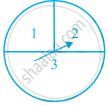Advertisements
Advertisements
प्रश्न
A game consists of spinning an arrow which comes to rest pointing at one of the regions (1, 2 or 3) (figure). Are the outcomes 1, 2 and 3 equally likely to occur? Give reasons.
उत्तर
No, the outcomes are not equally likely, because 3 contains half part of the total region, so it is more likely than 1 and 2, since 1 and 2, each contains half part of the remaining part of the region.
APPEARS IN
संबंधित प्रश्न
From a well-shuffled deck of 52 playing-cards, one card is drawn. Find the probability that the card drawn will not be a red card.
Two dice (each bearing numbers 1 to 6) are rolled together. Find the probability that the sum of the numbers on the upper-most faces of two dice is 7, 8 or 9.
In a game of chance, a spinning arrow comes to rest at one of the numbers 1, 2, 3, 4, 5, 6, 7, 8. All these are equally likely outcomes. Find the probability that it will rest at an odd number.

In a game of chance, a spinning arrow comes to rest at one of the numbers 1, 2, 3, 4, 5, 6, 7, 8. All these are equally likely outcomes. Find the probability that it will rest at a number less than 9.

A die is thrown 450 times and frequencies of the outcomes 1,2,3,4,5,6 were noted as given in the following table
| outcomes | 1 | 2 | 3 | 4 | 5 | 6 |
| Frequency | 73 | 70 | 74 | 75 | 80 | 78 |
(ii) a number < 4
A bag contains 10 red, 5 blue and 7 green balls. A ball is drawn at random. Find the probability of this ball being a not a blue ball.
All the jacks, queens and kings are removed from a deck of 52 playing cards. The remaining cards are well shuffled and then one card is drawn at random. Giving ace a value 1 similar value for other cards, find the probability that the card has a value 7
Complete the following table.
| Sr. No. | Random experiment | Sample space | Number of sample points in S |
| 1. | One coin is tossed. | S = {H, T} | n(S) = `square` |
| 2. | Two coins are tossed. | S = `square` | n(S) = `square` |
| 3. | Three coins are tossed. | S = {`square`, THH, HTT, THT, TTH, TTT} | n (S) = 8 |
| 4. | A die is thrown. | S = `square` | n(S) = `square` |
The table given below shows the months of birth of 36 students of a class:
| Month of birth |
Jan. | Feb. | Mar. | Apr. | May | June | July | Aug. | Sept. | Oct. | Nov. | Dec. |
| No. of students |
4 | 3 | 5 | 0 | 1 | 6 | 1 | 3 | 4 | 3 | 4 | 2 |
A student is choosen at random. Fill in the boxes.
Total number of students = `square`
Let E be the event that the selected student is born in June.
Then,
Number of times event E occurs = `square`
So, P (selected student is born in June)
P(E) = `"Number of students born in June"/square`
= `square/square`
= `square`
Which of the following cannot be the probability of an event?
